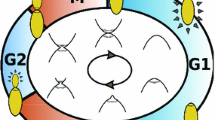Abstract
We show that when cell–cell feedback is added to a model of the cell cycle for a large population of cells, then instability of the steady state solution occurs in many cases. We show this in the context of a generic agent-based ODE model. If the feedback is positive, then instability of the steady state solution is proved for all parameter values except for a small set on the boundary of parameter space. For negative feedback we prove instability for half the parameter space. We also show by example that instability in the other half may be proved on a case by case basis.



Similar content being viewed by others
References
Bell GI (1968) Cell growth and division III. Conditions for balanced exponential growth in a mathematical model. Biophys. J. 8:431–444
Bell GI, Anderson EC (1967) Cell growth and division I. A mathematical model with applications to cell volume distributions in mammalian suspension cultures. Biophys. J. 7:329–351
Boczko EM, Stowers CC, Gedeon T, Young T (2010) ODE, RDE and SDE models of cell cycle dynamics and clustering in yeast. J. Biolog. Dyn. 4:328–345
Breeden LL (2014) \(\alpha \)-Factor synchronization of budding yeast. Methods Enzymol. 283:332–342
Breitsch N, Moses G, Young TR, Boczko EM (2015) Cell cycle dynamics: clustering is universal in negative feedback systems. J. Math. Biol. 70(5):1151–1175. https://doi.org/10.1007/s00285-014-0786-7
Buckalew R (2014) Cell cycle clustering in a nonlinear mediated feedback model. Discrete Cont. Dyn. Syst. B 19(4):867–881
Buckalew R, Finley K, Tanda S, Young T (2015) Evidence for internuclear signaling in Drosophila embryogenesis. Dev. Dyn. 244:1014–1021. https://doi.org/10.1002/DVDY.24298
Burnetti AJ, Aydin M, Buchler NE (2016) Cell cycle start is coupled to entry into the yeast metabolic cycle across diverse strains and growth rates. MBoC 27:64–74
Cohn A (1922) Über die Anzahl der Wurzeln einer algebraischen Gleichung in einem Kreise. Math. Zeit 14:110–148
Danø S, Madsen MF, Sørensen PG (2007) Quantitative characterization of cell synchronization in yeast. PNAS 104:12732–12736
Diekmann O, Gyllenberg M, Thieme H, Verduyn Lunel SM (1993a) A cell-cycle model revisited. Centrum for Wiskunde en Informatica, Report AM-R9305, pp 1–18
Diekmann O, Gyllenberg M, Thieme H (1993b) Perturbing semigroups by solving Stieltjes renewal equations. J. Differ. Integral Equ. 6:155–181
Diekmann O, Heijmans H, Thieme H (1984) On the stability of the cell size distribution. J. Math. Biol. 19:227–248
Duboc P, Marison L, von Stockar U (1996) Physiology of Saccharomyces cerevisiae during cell cycle oscillations. J. Biotechnol. 51:57–72
Futcher B (2006) Metabolic cycle, cell cycle and the finishing kick to start. Genome Biol. 7:107–111
Gong X, Buckalew R, Young T, Boczko E (2014a) Cell cycle dynamics in a response/signaling feedback system with a gap. J. Biol. Dyn. 8:79–98. https://doi.org/10.1080/17513758.2014.904526
Gong X, Moses G, Neiman A, Young T (2014) Noise-induced dispersion and breakup of clusters in cell cycle dynamics. J. Theor. Biol. 335:160–169. https://doi.org/10.1016/j.jtbi.2014.03.034
Hannsgen KB, Tyson JJ (1985) Stability of the steady-state size distribution in a model of cell growth and division. J. Math. Biol. 22:293–301
Hannsgen KB, Tyson JJ, Watson LT (1985) Steady-state size distributions in probabilistic models of the cell division cycle. SIAM J. Appl. Math. 45(4):523–540
Heijmans HJAM (1984) On the stable size distribution of populations reproducing by fission into two unequal parts. Math. Biosci. 72:19–50
Heijmans HJAM (1985) An eigenvalue problem related to cell growth. J. Math. Anal. Appl. 111:253–280
Kuenzi MT, Fiechter A (1969) Changes in carbohydrate composition and trehalose activity during the budding cycle of Saccharomyces cerevisiae. Arch Microbiol. 64:396–407
Lasota A, Mackey MC (1984) Globally asymptotic properties of proliferating cell populations. J. Math. Biol. 19:43–62
Moses G (2015) Dynamical systems in biological modeling: clustering in the cell division cycle of yeast. Dissertation, Ohio University, July 2015
Munch T, Sonnleitner B, Fiechter A (1992) The decisive role of the Saccharomyces cervisiae cell cycle behavior for dynamic growth characterization. J. Biotechnol. 22:329–352
Murray D, Klevecz R, Lloyd D (2003) Generation and maintenance of synchrony in Saccharomyces cerevisiae continuous culture. Exp. Cell. Res. 287:10–15
Robertson JB, Stowers CC, Boczko EM, Johnson CH (2008) Real-time luminescence monitoring of cell-cycle and respiratory oscillations in yeast. PNAS 105:17988–17993
Stowers C, Young T, Boczko E (2011) The structure of populations of budding yeast in response to feedback. Hypoth. Life Sci. 1:71–84
Tyson JJ, Hannsgen KB (1985a) The distributions of cell size and generation time in a model of the cell cycle incorporating size control and random transitions. J. Theor. Biol. 113:29–62
Tyson JJ, Hannsgen KB (1985b) Global asymptotic stability of the size distribution in probabilistic models of the cell cycle. J. Math. Biol. 22:61–68
Uchiyama K, Morimoto M, Yokoyama Y, Shioya S (1996) Cell cycle dependency of rice \(\alpha \)-amylase production in a recombinant yeast. Biotechnol. Bioeng. 54:262–271
Young T, Fernandez B, Buckalew R, Moses G, Boczko E (2012) Clustering in cell cycle dynamics with general responsive/signaling feedback. J. Theor. Biol. 292:103–115
Zietz S (1977) Mathematical modeling of cellular kinetics and optimal control theory in the service of cancer chemotherapy. Dissertation, Department of Mathematics, University of California, Berkeley
Acknowledgements
B.B. acknowledges support from the Grants EP/J013560/1 and OTKA K104745. T.Y. was partially supported by the National Science Foundation Grant 1418787. B.B. and T.Y. thank the staff of the Warwick Mathematics Institute for their hospitality while this paper was written.
Author information
Authors and Affiliations
Corresponding author
Rights and permissions
About this article
Cite this article
Bárány, B., Moses, G. & Young, T. Instability of the steady state solution in cell cycle population structure models with feedback. J. Math. Biol. 78, 1365–1387 (2019). https://doi.org/10.1007/s00285-018-1312-0
Received:
Revised:
Published:
Issue Date:
DOI: https://doi.org/10.1007/s00285-018-1312-0




